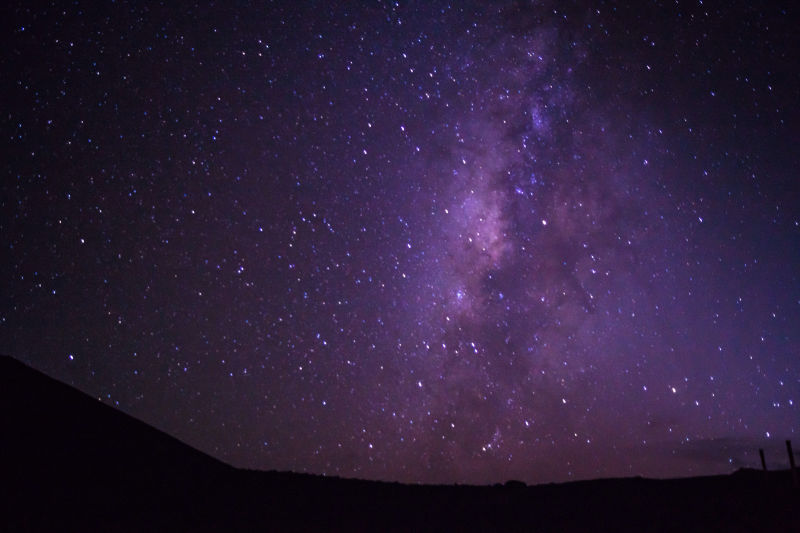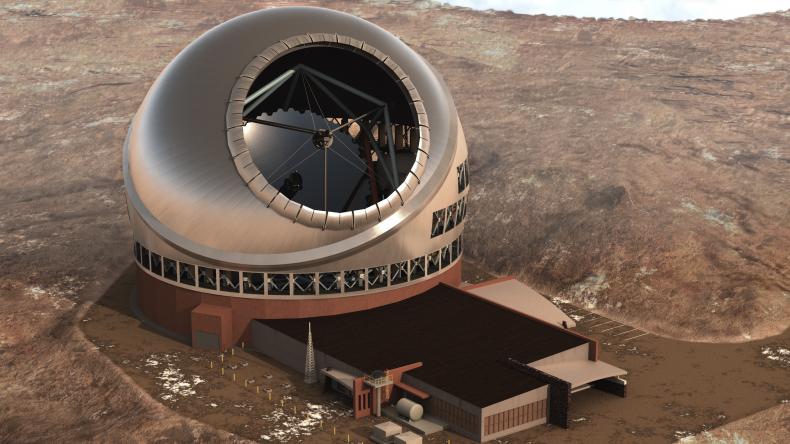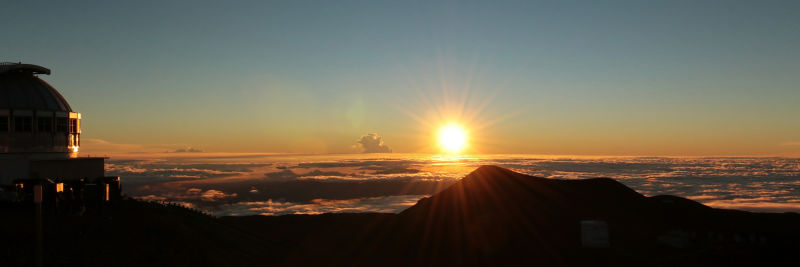Why the World’s Most Powerful Telescope Has Just Been Ruled Unlawful
INDIGENOUS RIGHTS, ASIA--PACIFIC, SCIENCE, 14 Dec 2015
Maddie Stone, Gizmodo – TRANSCEND Media Service
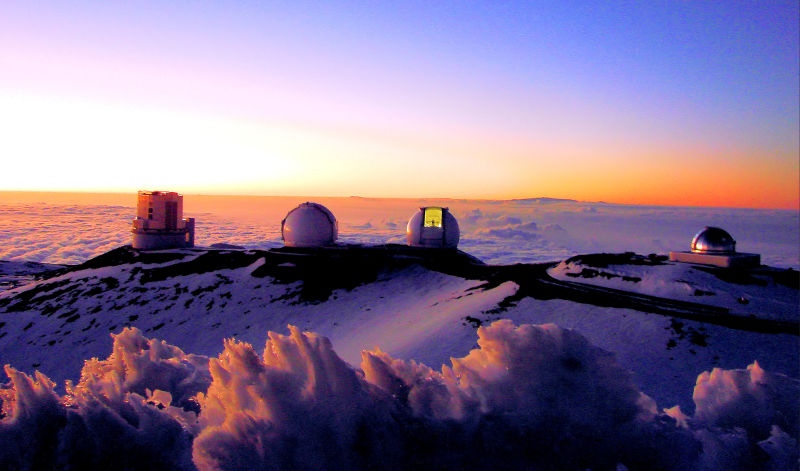
Four of the Mauna Kea, the Subaru Telescope, the Keck I and II telescopes, and the NASA Infrared Telescope Facility. Credit: Alan L.
7 Dec 2015 – Last week, Hawaii’s Supreme Court voided a construction permit for the Thirty Meter Telescope (TMT), a $1.4 billion observatory that would peer into distant corners of our universe and back in time, exploring new cosmic landscapes with a resolution twelve times sharper than that of Hubble.
The TMT is intended to be the flagship observatory of the northern hemisphere and the most powerful optical telescope on Earth. There’s just one problem: the telescope’s construction site, near the summit of the dormant volcano of Mauna Kea, has another celestial heritage. In the Hawaiian religion, Mauna Kea is a home of deities, the fiery birthplace of all life.
“Mauna Kea is an origins place,” Kealoha Pisciotta, a spokeswoman for the native Hawaiian organization Mauna Kea Anaina Hou, told Gizmodo. “It is not a realm for mankind, but a realm where we go to learn the ways of the heavens.”
To Pisciotta and her people, the eighteen-and-a-half story high TMT—the largest observatory by far on a summit that already hosts thirteen—would be a desecration. And after a bitter fight over the legality of the TMT’s construction, Hawaii’s advocates for the preservation of natural and cultural heritage have just scored a major win.
“For the Thirty Meter Telescope folks, this is a moment of reckoning,” science historian Leandra Swanner of Arizona State University told Gizmodo. “The TMT activists feel that justice has been served. But I don’t think it’s the end of the story.”
Two Celestial Traditions
A simmering cauldron of lava ensconced in a pile of basalt, Mauna Kea is the tallest mountain in the world, from its underwater base to its snowcapped peaks, which reach nearly 14,000 feet into the sky. The name “Mauna Kea” means white mountain, but some say it is short for “Mauna o Wākea,” after the Hawaiian sky father Wākea. In any case, it’s a sacred spot, home to several Hawaiian gods and numerous family burial grounds. For thousands of years, pilgrims have been drawn to its slopes, seeking wisdom and connection with otherworldly forces.
Mauna Kea is also where native Hawaiians learn about their traditional cosmological model of the universe. A thousand years ago, Pisciotta’s people were circumnavigating the Pacific, relying heavily on the stars as their guide. “We had an advanced system of navigation around the time of the birth of Christ,” Pisciotta told me. “A lot of that knowledge is derived from the mountain and the ceremonies we do there.”
Perhaps it’s no surprise that a mountain which was has long been a seat of cosmic teachings now attracts scientists seeking to unravel the greatest celestial mysteries of all. Unsullied by city lights or air pollution, Mauna Kea’s summit boasts some of the clearest skies in the world. For nearly fifty years, astronomers have built observatories there; today, the mountain is home to 13 world-class telescopes. Astronomy on Mauna Kea is a boon to the University of Hawaii and brings substantial income to the state.
Prized by astronomers, revered by Hawaiian cultural practitioners, Mauna Kea now finds itself at the center of an ideological clash. To native Hawaiians, the mountain offers connection with everything sacred, and they don’t want its natural majesty spoiled by anything. But to scientists trained according to secular Western principles, nature has no enchanted qualities: it’s something to be reduced, analyzed, and explained.
On Mauna Kea, Western logic is clear. “To move the TMT to another site would mean moving the TMT to an inferior site,” Nick Suntzeff, an astronomer at Texas A&M University, told Gizmodo in an email. For decades, Suntzeff has aided in site selection for Chilean telescopes, and he’s has had to eliminate some exceptional summits because of their cultural heritage. “The northern hemisphere is different,” he notes. “There are fewer sites that are outstanding. Mauna Kea is the best.”
The needs of astronomers on Mauna Kea have long held precedence over the wishes of those who would keep the mountain pristine. But in 2011, when Hawaii’s Board of Land and Natural Resources issued a construction permit for the mountain’s 14th observatory before Hawaiians could air their complaints in a court hearing, the seed was planted for an opposition movement that would change everything.
A Telescope Steeped in Controversy
The TMT would be the largest telescope in the northern hemisphere by a wide margin, rivaled only by two other massive scopes currently under construction in Chile. Sponsored jointly by Japan, China, the US, Canada, and India, and partially funded by nonprofits, the University of California and Caltech, the $1.4 billion observatory is a tremendous international collaboration. As Swanner puts it, “It’s big science at its biggest.”
This colossal investment will allow scientists to answer some equally big questions. The TMT’s 30-meter wide primary mirror will peer up to 13 billion light years away, traversing deep space and time to reveal the birth of galaxies at the beginning of the universe. The scope will also be an asset for exoplanet researchers, as one of the first ground-based observatories powerful enough to catch light bouncing off the atmospheres of distant planets. In these faint planetary flickerings, astronomers will search for “biosignatures,” mixtures of chemicals like oxygen and methane that could indicate alien biology.
So the TMT may help us answer the most profound questions about the place of the human species in the universe. But that knowledge would come at a price—the violation of a place held sacred by a people whose values have been overridden by Western colonial interests for more than a century.
“This isn’t simply a native beliefs versus science narrative,” Swanner said. “It is more accurately a natives versus settlers narrative.”
“You have an outside group coming in and making decisions about what should be done with native land without hearing native voices,” she continued. “That is very disturbing for cultural practitioners who don’t want to see themselves as a dispossessed people.”
Tensions over the construction of the TMT came to a head in October 2014, when a group of protestors halted the telescope’s groundbreaking ceremony by blocking its access road. In April, 300 protestors gathered on the mountain to block the TMT’s construction once again. Several dozen were arrested. On June 24th over 700 protestors gathered on the mountain, pushing boulders into the TMT access road and forcing construction crews to retreat. By that time, opposition to the telescope had gone viral on social media, and the Hawaiian cause was garnering allies across the world.
“Social media is playing a role I haven’t seen before,” Swanner said. “It is making the people in small groups on the mountain feel connected—feel that they are taking a stand with other groups around the world.”
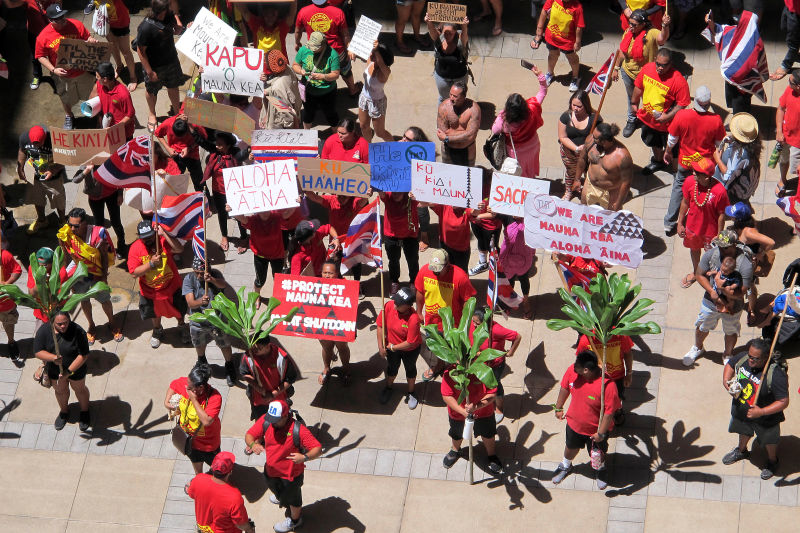
Protestors opposed to the TMT gather outside the Hawaiian Legislature on April 21st, 2015. Image Credit: AP Photo/Cathy Bussewitz
There have been attempts at reconciliation. Since 2010, TMT astronomers have held hundreds of “talk story” sessions, community meetings to share and discuss their work with the public. Plans to decommission older observatories are being accelerated, with governor David Ige vowing to remove at least three of the mountain’s existing telescopes by the time the TMT is operational in 2024. Just last month, the University of Hawaii confirmed that the TMT site is the last new area on the mountain that will ever be developed for astronomy.
But to many activists, these gestures are too little, too late. Moreover, they don’t address the real problem with the TMT: it’s utterly enormous. “The TMT will be very large and limit our ability to do ceremonies that need to see the star alignment,” Pisciotta explained. “Astronomy is permitted on Mauna Kea if and only if it can meet the strict regularly rules—and they aren’t doing that.”
That’s why the Mauna Kea Anaina Hou decided to take legal action. While Pisciotta would argue that the TMT is industrial development that violates the rules of Mauna Kea as a state-designated conservation district, the case that ended up in the Supreme Court was one of due process. Specifically, the court had to decide whether Hawaii’s Board of Land and Natural Resources was right to issue a construction permit for the TMT before a contested case hearing was held. It wasn’t. Last Wednesday, the TMT’s permit was ruled invalid.
“Quite simply, the Board put the cart before the horse when it issued the permit,” the court decision reads. “Accordingly, the permit cannot stand.”
***
Last week’s ruling was a major victory for the TMT’s opponents. But in light of everything that’s been invested in the observatory, it’s hard to imagine that the astronomy community will just give up. The telescope’s components continue to be built on schedule at facilities worldwide. To proceed with construction, the TMT will have to acquire a new permit from the board.
“TMT will follow the process set forth by the state, as we always have,” TMT’s chairman Henry Yang said in a statement. “We are assessing our next steps on the way forward.”
But if the TMT didn’t face an uphill battle with the Board of Land and Natural Resources before, it certainly does now.
“The permitting process should be tougher for them now, because there are more people who are publicly opposed, but also, because everyone is on their guard,” Jonathan Osorio, a history professor at University of Hawaii at Manoa told Gizmodo. “All of the people who made the decision to grant a license before holding the fair hearing will not be doing that this time around.”
Perhaps the most optimistic view is that this ruling becomes a watershed moment for astronomy, one where an open and honest dialogue between scientists and cultural practitioners begins to emerge. “I think that if we have honest dialogue, there might be some [compromise] that can be found,” Pisciotta said. “Something that maybe we didn’t think of before.”
“But,” she continued, “they have to be open to the fundamental question of should [astronomy] be allowed at all.”
To some astronomers, the price of building another observatory on Mauna Kea if an accord cannot be reached is simply too great. “To me, as a New Zealander, Native Hawaiian objections to astronomy on Mauna Kea look very similar to deeply held Māori positions on the use of the natural environment, which reflects the two cultures common Polynesian roots,” astrophysicist Richard Easther of the University of Auckland told Gizmodo in an email. “I hope that this latest development is an opportunity for dialogue and understanding, not just litigation—I wouldn’t want to see the TMT built at the end of a bitterly contested process.”
Even to cultural practitioners who oppose the observatory, this isn’t a black-and-white issue. Many native Hawaiians work closely with astronomers—Pisciotta herself was a telescope operator for over a decade. Time and again, she’s forced to defend her people against accusations that they’re anti-science. “If you wanted to build a hospital up there, we would still fight you—but it doesn’t mean we’re against healthcare,” Pisciotta said. “This is a land use issue.”
Will astronomy and spirituality one day co-exist in peace on Mauna Kea? It’s impossible to say at this point. When asking himself that question, Suntzeff recalls a conversation he had about Mauna Kea with an older Hawaiian woman in the early 1980s.
“I asked her what she felt about the observatory,” he said. “What she answered was at first strange to me. She told me that the problem with Mauna Kea is that on top of the mountain, people are too close to God. I leave it to you to put your own meaning on what she said, but I think that is wisest insight to the mountain I have heard.”
DISCLAIMER: The statements, views and opinions expressed in pieces republished here are solely those of the authors and do not necessarily represent those of TMS. In accordance with title 17 U.S.C. section 107, this material is distributed without profit to those who have expressed a prior interest in receiving the included information for research and educational purposes. TMS has no affiliation whatsoever with the originator of this article nor is TMS endorsed or sponsored by the originator. “GO TO ORIGINAL” links are provided as a convenience to our readers and allow for verification of authenticity. However, as originating pages are often updated by their originating host sites, the versions posted may not match the versions our readers view when clicking the “GO TO ORIGINAL” links. This site contains copyrighted material the use of which has not always been specifically authorized by the copyright owner. We are making such material available in our efforts to advance understanding of environmental, political, human rights, economic, democracy, scientific, and social justice issues, etc. We believe this constitutes a ‘fair use’ of any such copyrighted material as provided for in section 107 of the US Copyright Law. In accordance with Title 17 U.S.C. Section 107, the material on this site is distributed without profit to those who have expressed a prior interest in receiving the included information for research and educational purposes. For more information go to: http://www.law.cornell.edu/uscode/17/107.shtml. If you wish to use copyrighted material from this site for purposes of your own that go beyond ‘fair use’, you must obtain permission from the copyright owner.
Read more
Click here to go to the current weekly digest or pick another article:
INDIGENOUS RIGHTS:
- We Must Purge Genocide from the Marrow of Our Bones
- The Day of the World’s Indigenous Peoples
- ‘A World without Borders’: Revolutionary Love and Solidarity for Palestine
ASIA--PACIFIC:
- Identity Politics, Sexual Politics, and Violence against People in Sri Lanka
- The Hawaiians Who Want Their Nation Back
- The Hidden Meaning of the Martial Law in South Korea
SCIENCE:
